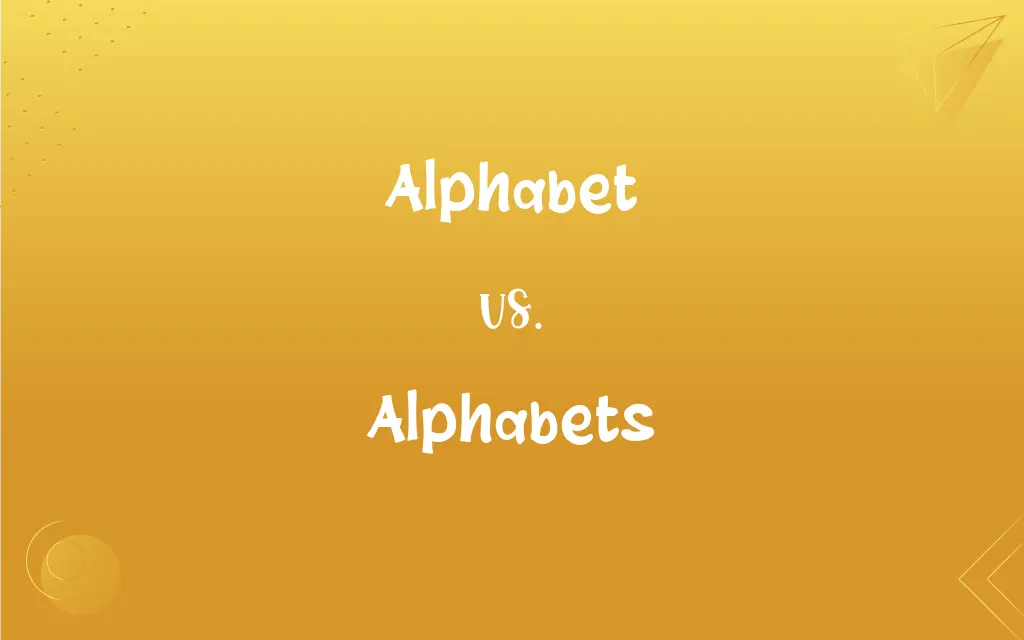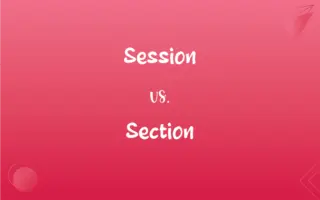Alphabet vs. Alphabets: What's the Difference?
By Aimie Carlson & Janet White || Updated on March 4, 2024
Alphabet refers to a set of letters used in a language, while "alphabets" indicates multiple sets from different languages or systems.

Key Differences
An alphabet is a standardized set of letters or symbols representing the phonemes of a spoken language. It forms the building blocks for written communication, allowing for the construction of words, sentences, and texts. On the other hand, the term "alphabets" is used to refer to more than one such set, implying the comparison or study of different linguistic systems or the use of multiple alphabetic systems within a multilingual context.
The composition of an alphabet can vary significantly in size and complexity, typically ranging from 20 to 30 characters in many languages. Whereas, when discussing "alphabets," one might explore the diversity across languages, such as the contrast between the 26 letters of the English alphabet and the 33 letters of the Russian Cyrillic alphabet.
Alphabets are designed to reflect the phonetic needs of a language, with each character representing a distinct sound. In contrast, the term "alphabets" suggests a broader exploration of how different languages accommodate their unique phonetic landscapes through varied sets of characters.
Cultural and historical factors heavily influence the development of an alphabet, shaping its evolution over time to meet the changing needs of its speakers. Conversely, examining multiple "alphabets" offers insights into the cultural and historical contexts of various languages, highlighting how each system captures the linguistic heritage of its people.
The study or use of an alphabet typically focuses on literacy within a single language, aiming to equip individuals with the skills to read and write. On the other hand, the study of "alphabets" might be part of comparative linguistics or multilingual education, emphasizing the understanding and appreciation of linguistic diversity.
ADVERTISEMENT
Comparison Chart
Definition
A set of letters forming a language's writing system.
Multiple sets of letters from different languages.
Purpose
To represent the phonemes of a single language.
To compare or study various linguistic systems.
Composition
Fixed number of characters specific to one language.
Diverse character counts across different languages.
Context of Use
Literacy and communication within one language.
Comparative linguistics or multilingual studies.
Cultural Significance
Reflects the phonetic and historical needs of a specific language.
Highlights linguistic diversity and cultural heritage across languages.
ADVERTISEMENT
Alphabet and Alphabets Definitions
Alphabet
A system used in literacy education.
Children's books often focus on teaching the alphabet.
Alphabets
Collections of linguistic symbols from various languages.
The museum exhibit displayed alphabets from around the world.
Alphabet
A cultural artifact.
The alphabet reflects the linguistic history of the English language.
Alphabets
Subjects of typographic art.
Artists create pieces that incorporate elements from multiple alphabets.
Alphabet
A complete set of letters for a language.
The English alphabet starts with A and ends with Z.
Alphabets
Components of multilingual education.
Multilingual classrooms teach several alphabets.
Alphabet
The basic component of written language.
Learning the alphabet is the first step in reading.
Alphabets
Tools for comparative linguistic studies.
Linguists study alphabets to understand phonetic diversity.
Alphabet
A tool for phonetic representation.
Each letter in the alphabet stands for one or more sounds.
Alphabets
Reflections of global linguistic heritage.
Alphabets encapsulate the cultural identities of different societies.
Alphabet
The letters of a language, arranged in the order fixed by custom.
Alphabets
The letters of a language, arranged in the order fixed by custom.
Alphabet
A system of characters or symbols representing sounds or things.
Alphabets
A system of characters or symbols representing sounds or things.
Alphabet
A set of basic parts or elements
"genetic markers ... that contain repeated sequences of the DNA alphabet"(Sandra Blakeslee).
Alphabets
A set of basic parts or elements
"genetic markers ... that contain repeated sequences of the DNA alphabet"(Sandra Blakeslee).
Alphabet
The set of letters used when writing in a language.
The Greek alphabet has only twenty-four letters.
In the first year of school, pupils are taught to recite the alphabet.
Alphabets
Plural of alphabet
Alphabet
A writing system in which letters represent phonemes. Contrast e.g. logography, a writing system in which each character represents a word, and syllabary, in which each character represents a syllable.
Alphabet
A writing system in which there are letters for the consonant and vowel phonemes. Contrast e.g. abjad.
Alphabet
(computer science) A typically finite set of distinguishable symbols.
Let be a regular language over the alphabet .
Alphabet
An individual letter of an alphabet; an alphabetic character.
Alphabet
The simplest rudiments; elements.
Alphabet
An agent of the FBI, the CIA, or another such government agency.
Alphabet
(rare) To designate by the letters of the alphabet; to arrange alphabetically.
Alphabet
The letters of a language arranged in the customary order; the series of letters or signs which form the elements of written language.
Alphabet
The simplest rudiments; elements.
The very alphabet of our law.
Alphabet
To designate by the letters of the alphabet; to arrange alphabetically.
Alphabet
A character set that includes letters and is used to write a language
Alphabet
The elementary stages of any subject (usually plural);
He mastered only the rudiments of geometry
FAQs
How many letters are in an alphabet?
The number of letters in an alphabet varies by language; the English alphabet has 26 letters.
What is an alphabet?
An alphabet is a set of letters used to represent the sounds of a language in written form.
What does "alphabets" refer to?
"Alphabets" refers to more than one set of letters from different languages or writing systems.
Can an alphabet have symbols other than letters?
Typically, an alphabet consists of letters without symbols, but some languages include diacritics or additional markers.
Can someone learn multiple alphabets?
Yes, people can learn multiple alphabets, especially if they are multilingual or studying comparative linguistics.
What role do alphabets play in cultural identity?
Alphabets can be significant cultural symbols, reflecting the history and values of the people who use them.
Why do different languages have different alphabets?
Different alphabets arise due to linguistic, historical, and cultural differences among languages.
How are alphabets created?
Alphabets are created based on the phonetic needs of a language and evolve over time due to linguistic and cultural influences.
What is the oldest known alphabet?
The oldest known alphabet is the Proto-Sinaitic alphabet, which dates back to around 1800 BCE.
Do digital technologies affect alphabets?
Digital technologies can influence how alphabets are used and represented, such as through fonts and digital writing tools.
Can alphabets influence the way we think?
Some theories suggest that the structure of a language's writing system, including its alphabet, can influence cognitive processes.
How do alphabets differ from syllabaries?
Alphabets consist of letters representing individual sounds, whereas syllabaries have characters for syllables.
Can alphabets be artistic?
Yes, alphabets can be subjects of artistic expression, with calligraphy and typography as common examples.
Are all writing systems based on alphabets?
No, some writing systems, like Chinese, are logographic and do not use alphabets.
Do alphabets change over time?
Yes, alphabets can change over time due to language evolution, reforms, or external influences.
What is the significance of alphabets in education?
Alphabets are foundational for literacy, enabling individuals to read, write, and communicate in a given language.
How do alphabets contribute to global communication?
Alphabets facilitate global communication by providing a basis for written language, essential for cross-cultural interaction and information exchange.
How does one study alphabets?
Studying alphabets can involve learning the characters, sounds, and writing rules of a language's writing system.
Why are some alphabets more complex than others?
Alphabet complexity often reflects the phonetic and phonological complexity of the language it represents.
Is there a universal alphabet?
There is no universal alphabet, but the Latin alphabet is widely used across many languages.
About Author
Written by
Aimie CarlsonAimie Carlson, holding a master's degree in English literature, is a fervent English language enthusiast. She lends her writing talents to Difference Wiki, a prominent website that specializes in comparisons, offering readers insightful analyses that both captivate and inform.
Co-written by
Janet WhiteJanet White has been an esteemed writer and blogger for Difference Wiki. Holding a Master's degree in Science and Medical Journalism from the prestigious Boston University, she has consistently demonstrated her expertise and passion for her field. When she's not immersed in her work, Janet relishes her time exercising, delving into a good book, and cherishing moments with friends and family.






































































